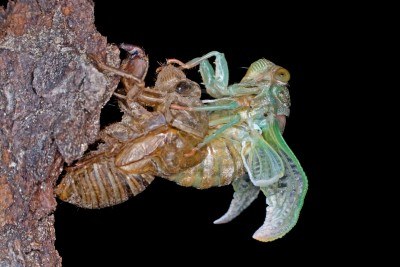
Reproduction
Tibican canicularis has a life cycle that begins around late summer with nymphs emerging from the soil and becoming mature cicadas. They begin a life cycle that will last from 2 to 5 years (Jackman and Drees, 1998).
The reproduction process begins with the males serenading the females with their loud, shrilling call. The males use their powerful, sound-producing organs to call to the females. These whitish, transparent drums rest below each wing on each side of the abdomen (Hall, 1902). These drums are controlled by powerful muscles inside the abdomen designed to vibrate the drums rapidly, producing a high-pitched, piercing sound. The adult's abdomen is filled with air sacs that will act as a sound board that can amplify and modify the sound (Cicada, 2013). Species of the genus Tibicen have the loudest song in North American with their call reaching up to 106 decibels (Cicada, 2013). The unbearable heat of mid-day June drives the cicadas to their greatest activity pushing them to call so loud that the noise of a swarm can be heard from a mile away or greater (Hall, 1902).
Females lack the ability to produce sound, but are able to hear the males calling to them in hopes of mating (Hall, 1902). Upon hearing this call from the males, the female immediately starts to flick her wings in unison with the male. This lets the male know he can come in to mate and he will produce a buzzing interference call to ward off other males wanting to mate (Milius, 2000).
After successful mating, the female seeks out tender twigs to lay her
eggs. Once she has found a sufficient twig, she uses her saw-like,
egg laying structure called an ovipositor
(Jackman and Drees, 1998). She pierces the wood and
lays two rows of eggs into the twig. After finishing the first nest,
she will walk up the twig to select a new spot and will begin to lay
her eggs again (Thone, 1929). Such
a process takes the female around 45 minutes to complete
(Loftin, 1953). During her month
or less of life as an adult, the maternal cicada may lay as many as
600 eggs. Then she dies (Thone, 1929). Over the course of 6 to 7 weeks
the eggs will hatch and the nymphs will drop to the ground and begin
to burrow into the soil.
 The nymphs will burrow several feet into
the soil in search of tree roots for nutrition
(Jackman and Drees, 1998).
When the time is right, on a warm, dry, clear day in June, the
hundreds of pupa who have awaited the day to emerge can finally feel
the fresh air above ground. They emerge eagerly from their holes or
living chambers and scatter to the nearest tree or vegetation to
anxiously begin the next stage of their life
(Thone, 1929). These young cicadas will have anywhere from 4 to 6
weeks to develop and mate before they die
(Milius, 2000).
The nymphs will burrow several feet into
the soil in search of tree roots for nutrition
(Jackman and Drees, 1998).
When the time is right, on a warm, dry, clear day in June, the
hundreds of pupa who have awaited the day to emerge can finally feel
the fresh air above ground. They emerge eagerly from their holes or
living chambers and scatter to the nearest tree or vegetation to
anxiously begin the next stage of their life
(Thone, 1929). These young cicadas will have anywhere from 4 to 6
weeks to develop and mate before they die
(Milius, 2000).
Click here to learn how it interacts
with other organisms!
Or
Go back to Home